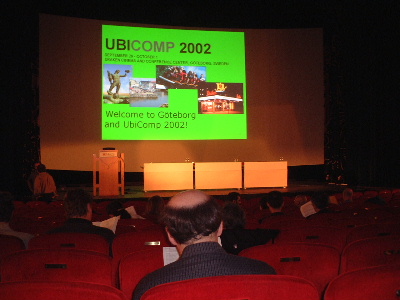Report from UBICOMP 2002
Goteborg, Sweden
September 31 - October 2, 2002
By Jonah Brucker-Cohen (jonah(at)coin-operated.com)

The conference began with workshops on Sunday. I participated in the "Emotions in the World" workshop focusing on how to contextualize emotions into tangible objects, people, environments, and physiological outcomes. Each group was given an emotion and asked to define it, describe and create a physical manifestation of it, draw its implications, and invent a new product or device that might address its nature. My group's emotion was anxiety - so you can probably imagine what types of responses we came up with. Our final concept was a networked shoulder massage machine to alleviate anxiety and stress that could only be triggered when someone else close to you also felt anxious - ie. when you were in "bodily sync" with that person.

I showed SpeakerPhone, a project I developed at MLE, in the poster session which was a room filled with posters of people who submitted shorter papers. These were abstracts of small-scale projects and practical prototypes that focused on some area of ubiquitous computing from PDA applications, to environmental tags, to using game engines for learning environments, to applications for networking tools. I received positive feedback on my poster from researchers passing by - some audio engineers who grilled me on the acoustic aspects of spatialized audio mapping (of which I told I wasn't a sound engineer). Some ideas for SpeakerPhone included embedding it in the walls of a domestic space for data visualization specifically in the kitchen or home. Also people really liked the telematic collaborative possibilities of SpeakerPhone for musicians or performers to collaborate on creating the ambience of a single connected space.
Downstairs from the conference auditorium, in the cinema's restaurant was a large-scale showcase from the EU funded, "Disappearing Computer" project. This display featured live and working demos of projects that dealt with future methods of embedding computing technology into everyday life. These included wearable computing focused on specific scenarios such as avalanche safety as well as Smart-Its (developed by PLAY research et al.), a platform for adding smart-tags to common objects in order to allow them to perform specific tasks based on their location such as finding lost children or monitoring the state of shipped egg cartons. Other applications included ubiquitous learning environments for architects where you could texture map dioramas by placing surfaces in front of a tag reader. Also shown was the "GossipWall", a large ambient public display that notifies you of personal messages (email, IM, etc..) in a non-obtrusive way.
Overall, the conference was a good intro to the world of ubiquitous computing. There still seems to be a layer of ambiguity surrounding whether or not this proposed future will truly augment our daily lives. Will it make us boring? Never leave our homes? Have too much information at our fingertips? The true realization might be to provide a balance between offering too much information and allowing our imagination to run free within a proposed framework. Many of the projects presented applications of embedded technology, but none of them thought about the human side of adjusting our lifestyles to incorporate this computation. Maybe that conference could be called CHI-OHMY.